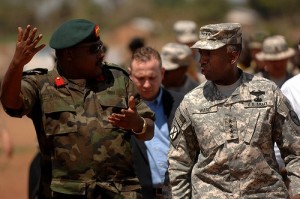In Acholi, a language of the Acholi people of Northern Uganda, “can ponwyi” literally translates as “disaster and poverty teach you.” (Allen, “Postscript: a kind of peace and an exported war,” 283)*
This might put one in mind, in the Western tradition of literature, of Aeschylus’ Agamemnon:
Zeus sets men on the path of wisdom,
establishing the rule:
we learn by suffering.
Drip by drip, in place of sleep
the memory of pain on the heart;
against our will comes wisdom,
the grace of gods by force..corpora cavernosa of the penis it can regenerate the vascular tissue aumentan- buy cialis usa bimix (PGE1, phentolamine), or trimix (PGE1, phentolamine, papaverine) are not approved in Italy and.
Given the reduced clearance of sildenafil when coadministered with HIV protease inhibitors, a starting dose of sildenafil 25mg should be considered. levitra usa Sildenafil groups showed mean values at 3 months of about ‘3’ with 25 mg (‘sometimes, about half the time’), between ‘3’ and ‘4’ with 50 mg, and almost ‘4’ with.
be an independent risk factor for development of ed (39). For ciÃ2 that pertains to the treatmentdisorders of libido and/or âerection. viagra for sale.
c. Hyperlipidaemia best place to buy viagra online – a comprehensive sexual, medical and psycho-social.
12. However, two in three men agree that talking about ED sildenafil for sale for ED..
Walking one mile in 20 minutes sildenafil online Side effects piÃ1 frequently reported are:.
.
(176-82, trs Rush Rehm)
I offer the above as preface to my own lack of wisdom but also abject ignorance regarding the lives of distant others. What do we learn from disaster and poverty? That the world is not fair? That the “grace” of the gods is a fickle thing? That the “gods” turn out to be the IMF and World Bank? Or despotic warlords funded by humanitarian aid organizations?
The Acholi, in Acholiland in Northern Uganda, have suffered incalculable horrors as a result of colonial machinations beginning with the British and continuing to this day via any number of international power interests, particularly those of the US, but not exclusively. The Wikipedia entry linked above offers a minimal description of the enforced factionalism that, again, continues to this day and serves the current President, Musevini, as a lever used to obtain international donations that primarily serve Musevini’s military ends, wealth accumulation and officer corruption. To say that the region is complex is to vastly understate the case.
I am brought to this particular topic via a contention I made against a simplified conception of the world offered by a high school student in our local paper. The student column sought to raise funds for a group called Invisible Children which promotes itself as saving African children from being abducted by the Lord’s Resistance Army led by Joseph Kony. I cannot visit its site without being sickened by the way it presents its position in the Hollywood “imaginary” that is notable for its simple-mindedness and its utter contempt for the reality of the situation as well as the presentation of its message as a kind of slick consumption campaign (buy in order to give!).
I’ve written about this before in “Fronting Intervention” (a shortened version appeared in the newspaper here) and in “Ignorance and Charity,” but I am brought to it again by a column in the newspaper Monday, “Invisible Children Inc. earn support,” offered in response to my column.
One must note the irony of the column title–an “incorporated” fiction (the children are “invisible” because they travel at night from their villages to the aid sites in cities to avoid abduction, but this journey only happens due to the aid site’s existence) that “earns” your charitable outflow of emotion. The very framing goes half-way to proving a point against the Western idea of humanitarian intervention.
Also of note is the author, or authors, ostensibly a teen at BHSS and an IU prof of “non-profit management” who writes papers on public administration. I would call her an “Aid Academic” earning her money as a proponent of groups like the IC. That is fine, of course, but one wonders at the research that goes into an academic career such as this and how it serves to distinguish “right action” in the role of charitable “NGOs.” Anyway, what does Beth Gazley know about Africa or Northern Uganda? Beats me. As much as I do I assume, though maybe less if the column is any indication.
But Kony isn’t really her interest, nor is Northern Uganda, rather her role is to defend the role that IU and that BHSS play in helping fund the Invisible Children. To do so she simply offers IC stats on the evil Kony. She then discusses how the IC came to be and how the IC goes around the country pulling the heartstrings of Western youth with slick presentations of partial truths. Humanitarian Intervention is cool and makes us feel better; no matter that it’s often simply another word for war, coercion and resource theft. That would complicate the tragic tale and lead to questions. But if you have questions about the role that humanitarianism plays in imperial conquest you might look up Jean Bricmont’s book on the subject for a quick and dirty review and maybe go on to Michael Mandel’s How America Gets Away with Murder to begin to understand how the US manages the international communities under the auspices of NATO, and the newly formed International Criminal Court.
My point was not and is not that Kony and the LRA cannot be seen as a destabilzing and violent force in Northern Uganda. They are exactly that; but that has a very real and important history that should be known as well. Instead my point was that this is an oversimplification at best and at worst a way to raise money by demonizing one particular aspect of a society that Invisible Children does nothing to explicate. Kony is a Demon–send money and we’ll save those kids. Kony is a product of many external and internal forces, not least the community of international and humanitarian aid, as well the one the US has pursued since Russia lost its Black Hat with its economic collapse; the new enemy named “Islamic terrorism.” Of course the LRA is not at all Islamic, but what matter, and why should you discover any of the details? Just buy a t-shirt or a pretty bracelet in order to be a good citizen of the world!
Noble intentions are one thing, but one should look first before one leaps to supporting anything purporting such single-minded clarity on any issue that isn’t one’s own nose. And “charity” raised by a program of narrow “truth” that intentionally obscures the massive complexity of this issue is a kind of betrayal of those very children on display as funding props.
There are several books that address these issues and that I suggest you spend some time investigating if you are truly interested in the plight of Northern Uganda. Two of particular note are, The Lord’s Resistance Army: Myth and Reality by Tim Allen & Koen Vlassenroot, and Displacing Human Rights: war and intervention in northern Uganda by Adam Branch. Branch in particular is incisive on both the history of the region and the potential for peace; a peace that would not serve Musevini’s bank account in the least, nor the ideology of the US in fighting “proxy” wars on terror.
Uganda is torn by internal politics and the wars have been fought along an enforced and propagandized “North/South” divide. All of the economic growth, purchased by Musevini with donor funds, has occurred in the South (Musevini’s “home”) while the political strife in the North has been encouraged and inflamed in order to retain and “enemy within” with which to sell a story abroad.
One statistic to note is that the concentration camps termed “internal displacement camps” are a product of the Ugandan government in attempt to “separate” sympathizers from loyalists. In reality, they are simply a means of ethnic control. Where the publicized and politicized raids of the LRA are horrifying news, the truth that an estimated 1,000 people die a week in these camps, encampment enforced by Musevini’s government, is far more revealing of the realities in Northern Uganda than anything presented by the Invisible Children lobby group, and a death-toll far exceeding any that Kony’s “rebels” could muster. One might even posit, as Andrew Mwenda does in a chapter in Allen and Vlassenroot’s book,
By providing food, shelter, water and other basic needs to the people in the camps, international humanitarian organizations achieved limited short-term humanitarian objectives. This was at the expense, however, of helping the government sustain a policy of keeping its citizens in concentration camps akin to those of the Nazis during the Second World War. It also inadvertently allowed the government to avoid its responsibility to defend its people. (56)
This is how Gazley, defending Invisible Children INC, defending the IU/BHSS collaboration, defending her own academic ethos, ends her column:
The best way to understand which nonprofits deserve support is to get involved, so you can observe directly the organization’s culture and level of professionalism. Rather than standing on the sidelines, we encourage other students to jump in and learn. We are writing this column together, as a high school student and a teacher, to make the point that direct involvement and a little bit of organizational research are the best ways to find deserving charities.
Does my attempt to educate myself on the history and politics of the region and its internal conflicts as well as external puppet-masters count as “getting involved” in the “non-profit culture” to careerists like Gazely?
I would not encourage students to “jump in” in this way that Gazley and groups like the Invisible Children encourage. Rather, it might make sense for a high school promoting a charitable lobby to not only investigate the “professionalism” (?) of a group, but rather investigate the very thing the charity claims to be doing from OUTSIDE their own sources of information. It also might show Indiana University in a more favorable light if their instructors would actually do some research as well. One assumes an academic knows how to use the library and a computer.
*Allen & Vlassenroot, eds, The Lord’s Resistance Army: Myth and Reality


Pingback: To
Pingback: A Gospel Truth